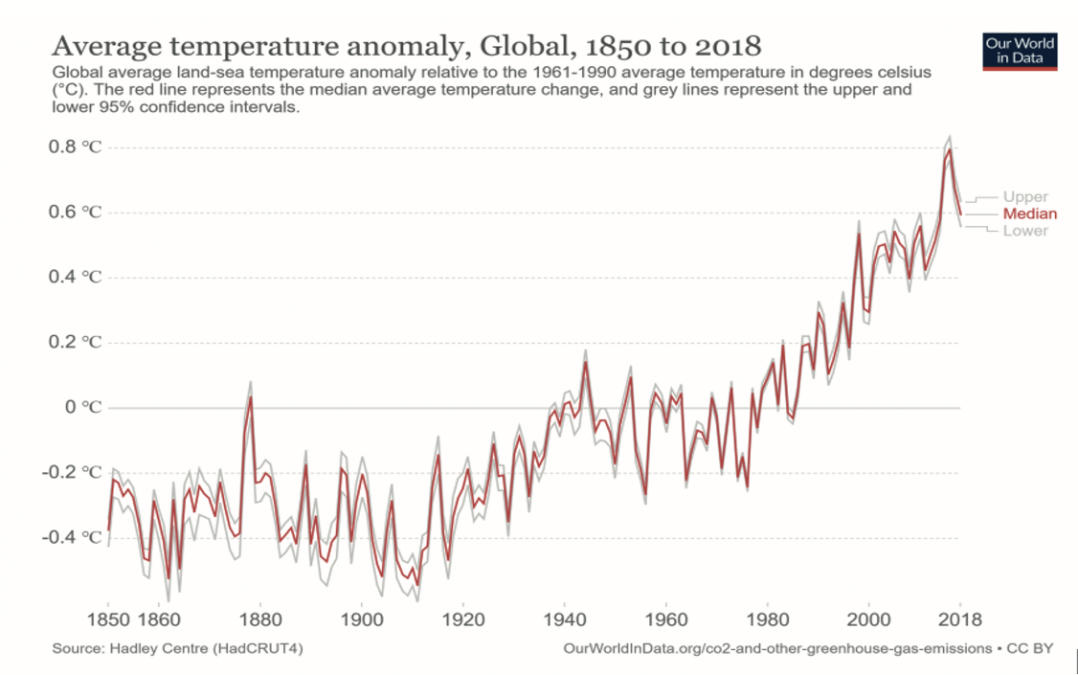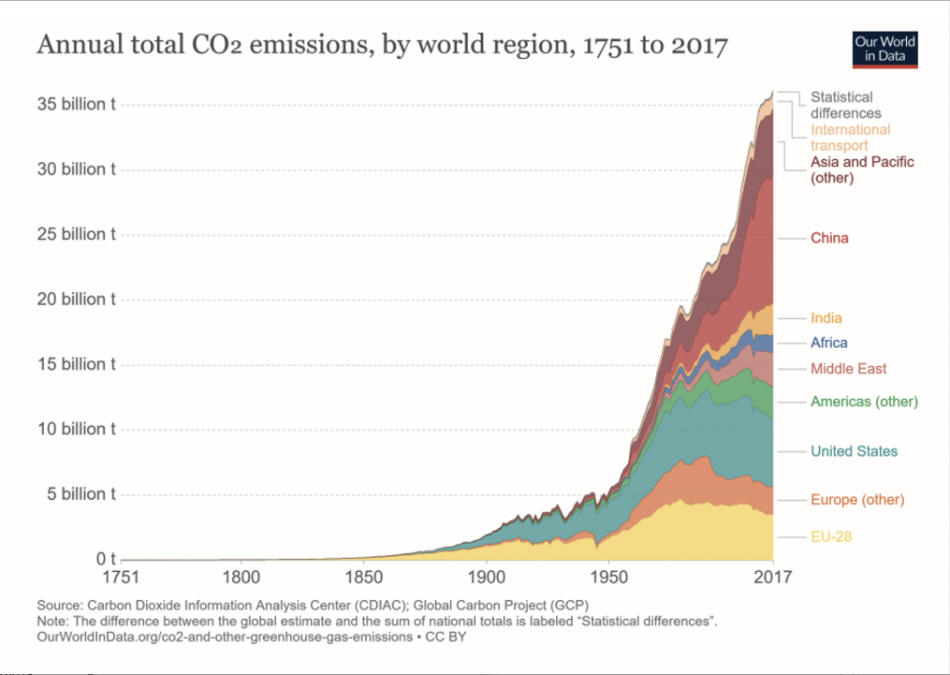- Homepage
- News and Features
- What greenkeepers should consider when thinking about climate change
What greenkeepers should consider when thinking about climate change

What strange times we live in. There we were, just a few months ago, going about our daily business and not thinking that our lives and livelihoods were about to be turned upside-down and inside-out by a virus spreading worldwide and for which humankind was totally unprepared. And then I learned a new word: furloughed.
As well as the clearly defined legal definition for this word, there is another definition which is just as pertinent: “to stay at home for a long time with a super-abundance of spare time”. So, in an effort to stay busy, I embarked on a project in my garden, started working through the pile of unread books in my bookcase and went on the hunt for some educational resources, including the BIGGA website (an absolute wealth of learning stuff!), the GCSAA website and Greenkeeper International.
In the April edition of Greenkeeper International there was an article entitled ‘Climate Change and What We Must Consider’. I read this with interest and, I have to say, a sense of unease.
It was certainly an interesting article discussing the future of golf courses in the face of the challenges thrown up by climate change, but I was feeling uneasy because while I know golf courses can do great things for the environment, like encouraging biodiversity and the protection of rare species and habitats, golf course maintenance does make some significant contributions to the atmosphere that are just a little bit less than desirable. Indeed, there was barely a mention in the article of the science behind climate change or steps the golf industry could take to reduce greenhouse gas emissions.
A warming planet
There is no doubt that the earth is warming; Global Mean Surface Temperature (GMST) is rising, glaciers are retreating, the polar ice caps are shrinking, plants and animals are moving as their habitats change and the consensus within the scientific community is that warming is caused by anthropogenic (human) activities.
The graph below demonstrates temperature rise globally from 1850 to 2018.

Following extensive research and data analysis, the International Panel for Climate Change (IPCC) concluded that GMST rose by 0.6°C in the 20th Century and parts of the Antarctic warmed up by 2.5°C.
The greenhouse effect
For millennia, our planet’s temperature has been defined principally by the sun: its surface warms as radiation is absorbed, but some of the radiation that hits the surface is reflected back.
But that’s only part of the story: while some of that reflected and irradiated radiation is lost back in space, some (long-wave radiation that is trapped and absorbed by greenhouse gases) is reflected back to the surface, where it is reabsorbed and re-emitted, creating a positive warming effect. Without this natural recycling of radiation – known as the greenhouse effect – the extent of radiation loss to the atmosphere would mean that the Earth’s average temperature would be a chilly -19°C.
The greenhouse effect and the gases that cause it have regulated the GMST and not only made the planet nicely conducive to human existence, but have made some pleasant conditions for grass growth. Technological advancements at the beginning of the 19th Century brought about the Industrial Revolution and the burning of fossil fuel increased drastically, with greenhouse gas concentrations in the atmosphere rising. These gases caused more radiation to be reflected and re-emitted in a cycle, creating the enhanced greenhouse effect and rising GMST.
Samples from ice cores provide an accurate record of gas concentrations in the atmosphere over a long period. From these ice cores, we know atmospheric concentrations of carbon dioxide were stable from 1000AD until the start of the Industrial Revolution at around 280 parts per million (ppm) but reached 370ppm by 2000 and are now over 400ppm. There were similar percentage increases for other greenhouse gases like nitrous oxide (N2O) and methane (CH4).
How CO2 emissions have increased is shown here:

Although CO2 comprises only 0.5% of atmospheric gas, it is far more abundant and therefore has more impact on the enhanced greenhouse effect than other greenhouse gases. Also, CO2 is at the forefront of climate science discussions because humans are responsible for its current atmospheric concentrations. N2O and CH4 are much more potent but their concentrations are far lower. There are other greenhouse gases, much more potent still, but they are present in very small concentrations.
How are greenhouse gas emissions relevant to golf?
When I go out to cut fairways on a bright sunny morning, should I stop to consider that burning one litre of diesel will add 2.68kg CO2 to the atmosphere?
If it takes eight hours to cut the fairways and the machine uses around 40 litres of diesel, 107kg of CO2 will have been produced. A golf course might have five greenkeepers running different machines all day so their total contribution of CO2 to the atmosphere will be well in excess of 500kg.
Let’s put this into stark reality: a tree of average size will absorb around 20kg of CO2 in one year and one ton of CO2 can melt 0.7m3 of Arctic ice.
The example above shines a light on the extent of CO2 emissions from running golf course maintenance machinery. But is that the total of emissions resulting from golf course management? There are many other contributors:
- Diesel combustion also emits N2O into the atmosphere
- Large quantities of CO2 and N2O are emitted in the extraction and transportation of topdressings, sands etc
- Use of mineral fertiliser: nitrogen is a very stable element and the manufacture of nitrogenous fertilisers from the air requires high temperatures and pressures using the Haber Bosch process. The colossal scale of the Haber Bosch process emits around 2% of total global CO2 emissions and although most fertiliser is used in agriculture, a large proportion of greenhouse gas emissions from golf course maintenance derive from mineral fertiliser
- Overuse of nitrogen fertiliser increases N2O emissions from the soil
- Decomposing grass clippings release CO2 and N2O, exacerbated by excess fertiliser and irrigation

Carbon sinks?
I was chatting to a golf course consultant not so long ago and he told me that grassland is a net carbon sink - where more carbon is absorbed than released. Unmanaged grassland most certainly is a carbon sink but intensively managed turf is not.
A 2010 study (Bartlett & James) of two British golf courses showed both to be net contributors of greenhouse gases. It is worth noting that a golf course site that is surrounded by mature woodland or with large tracts of less-intensively managed roughs may indeed be a carbon sink.
But isn’t the net carbon argument missing the point? Concentrations of greenhouse gases in the atmosphere are too high, they are rising and we need to both drastically reduce emissions and find a way to lower current accumulations. Carbon neutrality appears to be a political construct that obscures that fundamental necessity of reducing emissions of greenhouse gases.
And shouldn’t we be worried that the CO2 and N2O that we are emitting now will still be circulating in the troposphere and exerting a positive radiative force in 100 years?
Potential reductions in greenhouse gas emissions
There are simple ways to reduce greenhouse gas emissions from golf courses but they would require some pretty fundamental re-thinking by the industry and golfers alike. Reducing management intensity, fertiliser and topdressing use would be the first obvious steps but we would have to accept that the highly manicured surfaces that we currently enjoy would be compromised. I have played a bit of golf over the years and I love to see a well-presented golf course and to hit shots off tight, dense turf but in the context of climate change, I cannot have any meaningful objections if the grass on the fairways is a bit longer or the rough is a bit thicker or the fairways have not been fed and topdressed, or some bunkers were filled in (yes please).
Also, many golf courses are well positioned to help reach the The UK Climate Change Committee’s target to plant 1.5 billion trees in order to sequester carbon from the atmosphere
Looking further ahead, advancements in battery technology will help the industry move away from internal combustion engines and maybe we could find ways to make on-site green energy economically viable.

Weather records shows us the climate is changing and the scientific community are over 95% certain that the current changes are due to the enhanced greenhouse effect. We understand that we need to reduce emissions of greenhouse gases and we know there are ways to remove carbon dioxide from the atmosphere.
While the discussions about floods, droughts, coastal erosion and the like in ‘Climate Change and What We Must Consider’ are perfectly valid, the article seemed to me to miss a fundamental argument. I agree that we have legitimate concerns about the effects of climate change and their impact on golf courses and we need to plan and act to mitigate those effects.
But when we talk about climate change, what is it that we really must consider if not a complete change in how we maintain our golf courses?
Richard was writing for Greenkeeper International, the monthly journal for members of the British & International Golf Greenkeepers Association. If you'd have a topic of discussion that you'd like to contribute to the magazine, email GI editor Karl Hansell on [email protected]
Author

Richard Andrews
Richard Andrews is a BIGGA member and a first assistant greenkeeper

